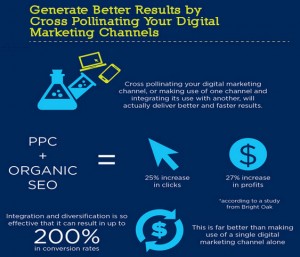To succeed in ecommerce, it’s not about being able to drive tons of traffic to your website—it’s about being able to attract the right people. Sending hundreds of thousands of people to your website might help you build brand awareness, but unless you’re focused on engaging with qualified shoppers who actually want your products, you won’t get very far.
So, the question is, where do you start?
How do you ensure that the people who land on your website throughout the day are people who fall within your target audience? How do you find the right people off-site and convince them to visit your store?
Here are 8 ideas worth implementing that can help you drive more qualified traffic to your ecommerce store:
1. Tell Relatable Stories
One of the most effective ways to connect with the right people offline is to tell stories that your target audience can relate to.
Because of the nature of ecommerce, you don’t have the opportunity to meet with your customers face-to-face. You can’t make a good first impression in person, you can’t start building rapport, from the moment someone walks through your door, and you can’t create a physical environment that helps them understand what your products and brand is all about.
Stories allow you to humanize your brand and connect with your target audience on a more personal, relatable level.. Stories can help online consumers quickly decide if you understand who they are, if you know what they need help with and how to help, and whether or not you’re the right company to buy from.
In the past few years, more and more brands have started investing in storytelling as a way to connect with their customers. The brands that find the most success are the ones that are willing to spend the time and money to develop high-quality content that focuses on people, not products.
Most of these brands are also using video as the primary medium for crafting and sharing stories that their customers can relate and attach to. Here are a few examples:
1. Yeti:
2. WildBird:
To start telling stories that your ideal customer can relate to, ask yourself these questions:
- Who are my customers?
- What do they care about?
- Why do they come to my shop?
- How can I help them?
- What stories will compel them to act?
- What stories make our brand or products unique?
Once you have some of the answers to these questions, read this post to get actionable tips on how to create and share your stories.
2. Become a Source for Answers
To drive more qualified traffic to your website, you need to become a source that your ideal customer can stumble upon when typing their questions into Google. In fact, you need to become the source that people rely on when they have questions that relate to your industry and the solutions your products provide to people. The easiest way to do it is by building and executing on a content marketing strategy for your ecommerce store.
A lot of people confuse blog post writing with content marketing—but they are very different. When you’re writing (or hiring someone to write) blog posts, you’re usually only concerned with publishing new content on your website each week, and meeting a certain word count requirement for each new piece of content. When you’re writing as a content marketer, on the other hand, you’re thinking about how to provide value that ultimately builds brand awareness, drives qualified traffic to your website and product pages, and converts visitors.
To be an effective content marketer for ecommerce, you have to focus on providing value above else—but you also need to be thinking about the ROI. The content you create needs to result in sales.
So, how do you do it?
There are obviously a number of strategies and tactics that should be included in your content marketing strategy, but one of the most important pieces relates to finding the right keyword phrases to target when creating new content.
To find the right opportunities, you need to spend time performing keyword research. If you’ve never performed keyword research in order to come up with new blog ideas, take a few minutes to read through this post. It provides a good introductory overview that can bring you up to speed.
Here’s how keyword research for content marketing works in a nutshell:
1. You have a few ideas about the types of topics and questions your target customers are searching for in Google when they need help.
2. You want to rank on page 1 of Google for the phrases your ideal customers are searching for.
3. You use Google Keyword Planner or another similar tool to identify keyword phrases that you can compete against.
4. You create amazing, valuable, 10x content that references those keywords.
5. If done correctly, your new blog post eventually ranks on page 1 whenever those keywords or keyword phrases are searched for by your customers.
By showing up on page 1 of Google for keyword phrases that relate specifically to the products you offer or industry you operate in, you’re ensuring that the right people (people who might be interested in buying products from you) are finding and traveling to your website.
3. Build a Passionate Community of Advocates
Another great way to drive qualified traffic to your ecommerce store is by building a community of advocates who can help you spread awareness about your brand and products. At the end of the day, online consumers want to work with companies that they know they can trust. The fastest way to build trust with people is by showing them that their friends already trust you.
There are a number of ways to go about building a community that supports your brand and products. Here are a few ideas:
1. Create a movement—help your customers rally behind some sort of mission that you’re trying to achieve with your products. Are you trying to help people become more adventurous? More active? More relaxed? Think about who your customers are and how your products bring them all together.
2. Leverage user-generated content—ask your happy customers to share authentic photos and videos of themselves using your products. Feature this content on your website, in email campaigns, on social media, and on product pages themselves. Make people feel like they’re an important piece of your story and your success.
3. Launch a referral program—Offer customers rewards and incentives in exchange for telling their friends and family members about you. Make it incredibly easy for people to spread the word about your products, your story, and your company.
4. Support a Cause—Pick a charity or nonprofit organization that you’re passionate about and donate some of your proceeds to that supports the cause. Make sure your customers and the people who visit your website know about the cause you support and how their money helps.
When you build a community around your brand and products, you gain access to more people who fall within your target audience.
4. Partner with Other Brands and Influencers
You can also gain access to more people who may fall within your target audience by partnering with the right brands and influencers. Influencer marketing is a big trend right now, and more ecommerce companies are starting to take notice.
The idea behind influencer marketing is pretty simple: connect with well-known celebrities, personalities, or brands in order to get more exposure and gain access to a new audience that you otherwise might not have been able to get direct access to.
Here are some ways you can partner with other brands and influencers as an ecomerce company:
- You can work with another brand or celebrity to collaborate on a limited-edition product.
- You can create and launch email marketing campaigns for each other’s audiences.
- You can create advertising campaigns for sites and apps like Instagram, YouTube, or Snapchat that leverage viral celebrities on each platform.
- You can rally behind the same cause or support the same nonprofit.
- You can allow an influencer to ‘take over’ one of your social media accounts for the day in order to drive more interaction and engagement with your social media followers.
The goal here is to widen your audience and gain instant trust by working with the right people and brands.
A word of caution: be careful with who you ultimately decide to partner with: whoever you choose should align with your mission and values and should be respected and well-liked by your existing group of customers.
5. Go Where Your Customers Are
One big mistake that a lot of ecommerce companies make is trying to create a presence on too many social media sites and apps. Five to ten years ago the options were simple: Facebook and Twitter. But now there are many more sites to choose from—Snapchat, Pinterest, Instagram, Periscope, etc. It can get overwhelming pretty quickly if you try to participate actively and consistently on every social media site.
To be successful in building relationships with people and actually convincing them to visit your shop, you’re much better off focusing on just one or two social media sites.
The best piece of advice I can offer here is to go where your customers are. If you find that they spend more time on one social media site more than another, focus on the one where they are most active.
If you’re not sure which sites your customers are spending the most time on, consider the demographics of your ideal customer, then review this report from Pew Research.
6. Pay-to-Play
I couldn’t write this post without mentioning the importance of spending money on social advertising in order to drive more qualified traffic to your website. It’s simply a MUST. If you’re relying solely on organic interaction and engagement on these sites in order to drive more customers to your website, it’s not going to happen. You have to be willing to pay to get the kind of ROI you’re looking for from sites like Facebook.
If you haven’t spent much time testing out social ads for your ecommerce business, I recommend starting with Facebook.
Start small with your budget, run a few tests, then adjust accordingly in order to get the most ROI from your efforts and money.
7. Try Something Wildly Different
Sometimes in order to get noticed by the right people, you need to do something wildly different than anyone else in your space. If you’ve been implementing a number of marketing tactics to drive awareness about your brand and products and traffic to your website, but nothing seems to be working, it might be time to try something more drastic.
Think about what you can do to create viral buzz about your company and products. If you’re a big ecommerce company with a large budget, you might be able to do something pretty amazing, such as:
- Launching a physical pop-up store in a major city
- Making one customer’s dreams come true and sharing the story on video
- Working with a big (BIG) name influencer to drive more awareness about your brand
- Creating a web series and hiring well-known actors or YouTube celebrities to act in your show
If you’re not as big and you don’t necessarily have a big budget for doing something big, don’t worry—you can start small and still make a huge impact. It all comes down to your ability to delight your customers. All you need to do is surprise them with random acts of kindness to prove to them that you value their business.
8. Make Customer Engagement a Priority
Finally, in order to drive the right traffic to your website, you need to take care of your existing customers. After all, they are the ones who have the power to leave really good or really harmful reviews about your products and business. In order to control the message, just make an effort to make customer an engagement a priority at your ecommerce business.
What does that mean, exactly? It means thanking customers for buying one of your products, following up with them, seeing if they have any questions or need any help, surprising them with coupons and special offers, making them feel like VIPs, and being willing to engage and communicate with them even after you’ve made the sale.
When you keep your customers happy, they brag about you to their friends—it’s as simple as that 🙂
Over to You
What other tactics are you implementing to drive more qualified traffic to your ecommerce store? Tell me in the comments below.
Digital & Social Articles on Business 2 Community(66)





